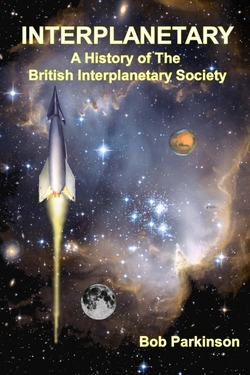Centauri Dreams
Imagining and Planning Interstellar Exploration
Best Images Yet of Fomalhaut Debris Disk
The ongoing dimming of Boyajian’s Star will result in a flood of new data from a wide variety of instruments worldwide, excellent news for those trying to piece together what is happening here. I hope you saw Tabetha Boyajian’s interview with David Kipping over the weekend, but if not, you can see it archived here. I tracked the story on Twitter all weekend, and as I did so, I was reminded of the recent news about Fomalhaut, where massive comets may explain what we are seeing in the star’s debris disk. You’ll recall that early in the work on Boyajian’s Star, comets were one explanation for its anomalous light curves, and it will be interesting to see whether the cometary hypothesis can stand up to the influx of new information.
Interesting as well to look at the new data in terms of Kepler’s, asking whether this is a periodic dimming, and hence not the result of intervening material between us and the star.
Latest photometry from last night; this event seems to have ended, but remember than in Q16 they came in clumps.@tsboyajian pic.twitter.com/serFLLFXL9
— Jason Wright (@Astro_Wright) May 22, 2017
We’ll see! And as I continue to keep one eye on my Twitter feed, let me segue into Fomalhaut.
A Stunningly Imaged Debris Disk
The ALMA radio telescope (Atacama Large Millimeter/submillimeter Array) has given us the first complete view of the star’s prominent circumstellar disk in millimeter-wavelength light. One of the brightest stars in our sky, Fomalhaut (? Piscis Austrini) is about 25 light years from the Sun, an A-class star whose excess emission in the infrared has flagged the presence of a circumstellar disk. We actually have a K-class star here as well (TW Piscis Austrini) and an M-class dwarf (LP 876-10), making up a widely spaced triple system. And around it we have a band of icy dust some 2 billion kilometers wide, circling the star 20 billion kilometers out.
What is striking about the composite image (incorporating Hubble’s optical data in blue as well as the ALMA results) is how well-defined the disk of debris and gas appears. We had earlier ALMA imagery taken when the array was still under construction in 2012 that showed about half of the debris disk, but we now get the complete view, one whose data reveal similarities between cometary material in our own Solar System and the debris around Fomalhaut.
“ALMA has given us this staggeringly clear image of a fully formed debris disk,” said Meredith MacGregor, an astronomer at the Harvard-Smithsonian Center for Astrophysics in Cambridge, Mass., and lead author on one of two papers accepted for publication in the Astrophysical Journal describing these observations. “We can finally see the well-defined shape of the disk, which may tell us a great deal about the underlying planetary system responsible for its highly distinctive appearance.”
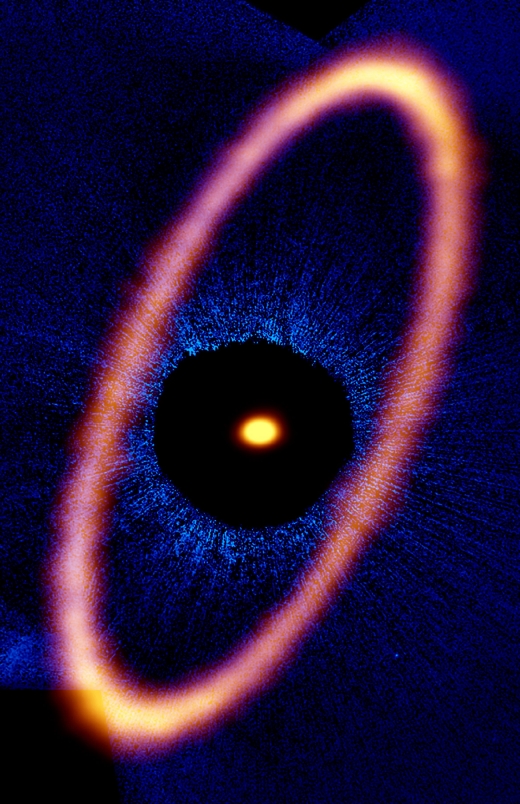
Image: Composite image of the Fomalhaut star system. The ALMA data, shown in orange, reveal the distant and eccentric debris disk in never-before-seen detail. The central dot is the unresolved emission from the star, which is about twice the mass of our sun. Optical data from the Hubble Space Telescope is in blue; the dark region is a coronagraphic mask, which filtered out the otherwise overwhelming light of the central star. Credit: ALMA (ESO/NAOJ/NRAO), M. MacGregor; NASA/ESA Hubble, P. Kalas; B. Saxton (NRAO/AUI/NSF).
You’ll also note in both images in today’s post that the disk seems brighter in two places, at about the 1 and 7 o’clock positions. This is intriguing: It tracks a prediction made last year by MIT’s Margaret Pan, who contributed to both the papers that have just appeared on the ALMA work. Pan pointed out that the dusty material in the Fomalhaut disk travels more slowly at apoapsis, when the disk is at its furthest from the star. The slowdown allows denser concentrations of dust to form, which show up as bright millimeter-wavelength emission.
This is a relatively young system at 440 million years old, making it about a tenth the age of our Solar system, and we may be seeing a system going through its own version of our Late Heavy Bombardment. Some 4 billion years ago, the Earth was frequently impacted by asteroids and comets, material left over from the formation of the system.
The Fomalhaut system is also familiar in that carbon monoxide shows up strongly in the ALMA findings. The data peg the relative abundance of carbon monoxide and carbon dioxide around Fomalhaut as roughly similar to what we see in comets found in our Solar System. Comet collisions may be releasing the gas in these quantities, perhaps even the impacts of huge comets of the kind that some have suggested around the enigmatic Boyajian’s Star.
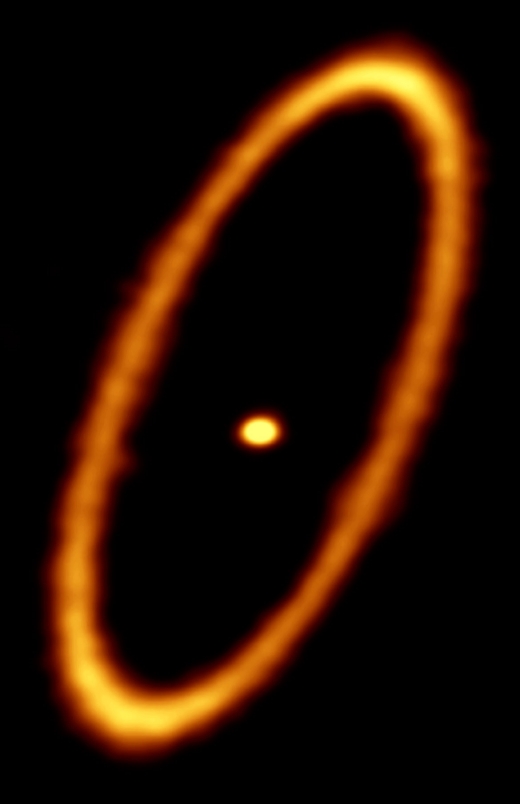
Image: ALMA image of the debris disk in the Fomalhaut star system. The ring is approximately 20 billion kilometers from the central star and about 2 billion kilometers wide. The central dot is the unresolved emission from the star, which is about twice the mass of our sun. Credit: ALMA (ESO/NAOJ/NRAO); M. MacGregor.
We already have an intriguing object here in the form of Fomalhaut b, which has been directly imaged, in a 1700 year highly elliptical orbit with apastron at about 300 AU. It is currently 110 AU from its host. Are there planets within the ring? Evidence points in that direction. The researchers were able to develop computer models that, along with the ALMA data, helped them calculate the width and geometry of the Fomalhaut disk. The disk has similarities to our own Kuiper Belt, as the paper notes, and its shape is telling:
The Fomalhaut debris disk is similarly narrow to the main classical Kuiper Belt in our own Solar System, which is radially confined between the 3:2 and 2:1 orbital resonances with Neptune implying a fractional width of ? 0.18 (Hahn & Malhotra 2005). In contrast, both the HD 107146 (Ricci et al. 2015) and ? Corvi (Marino et al. 2017) debris disks appear much broader with fractional widths of > 0.3.
That very narrowness has been seen as an indicator of planets, and not just by the authors of the current papers. But compelling as the evidence is, it is not yet conclusive:
Boley et al. (2012) propose that the narrow ring observed in Fomalhaut may also result from interactions with planets, namely two shepherding planets on the inner and outer edges of the belt. If the structure of the belt is indeed due to truncation by interior and exterior planets, we would expect to see sharp edges. However, given the resolution of our observations (? 10 AU) compared with the width of the belt (? 14 AU), we are unable to place any strong constraints on the sharpness of the disk edges.
Seeing the Fomalhaut disk at his level of detail gives us insights into early planet formation as we try to tease out the underlying planetary system that seems to be emerging. And the chemical similarities within this band and comets in our own system tell us that the processes occurring here may well parallel conditions in our own outer system’s infancy.
The papers are Macgregor et al., “A Complete ALMA Map of the Fomalhaut Debris Disk” (preprint) and Matrà et al., “Detection of exocometary CO within the 440 Myr-old Fomalhaut belt: a similar CO+CO2 ice abundance in exocomets and Solar System comets,” accepted at the Astrophysical Journal (preprint).

New Dip for Boyajian’s Star
Twitter action has been fast and furious with this morning’s news of the first clear dip in light from Boyajian’s Star (KIC 8462852) since the Kepler data.
#TabbysStar IS DIPPING! OBSERVE!! @NASAKepler @LCO_Global @keckobservatory @AAVSO @nexssinfo @NASA @NASAHubble @Astro_Wright @BerkeleySETI
— Tabetha Boyajian (@tsboyajian) May 19, 2017
I’m on the road most of today and so couldn’t get off a full post, but I did want to pass along Tabetha Boyajian’s newsletter, short but sweet.
Hello all,
We have detected a dip in progress!
Not much time to share details – we are working hard coordinating followup observations.
Here is a snapshot of LCO data for the Month of May. Stay tuned!
~Tabby et al.

And here is Jason Wright’s video chat on this event during his visit to UC Berkeley.

Detecting Photosynthesis on Exoplanets
Although many of the nearby stars we will study for signs of life are older than the Sun, we do not know how long it takes life to emerge or, for that matter, how likely it is to emerge at all. As we saw yesterday, that means plugging values into Drake-like equations to estimate the possibility of detecting an alien civilization. We can’t rule out the possibility that we are surrounded by planets teeming with non-sentient life, fecund worlds that have no heat-producing technologies to observe. Fortunately, we are developing the tools for detecting life of the simplest kinds, so that while a telescope of Colossus class can be used to detect technology-based heat signatures, it can also be put to work looking for simpler biomarkers.
Svetlana Berdyugina (Kiepenheuer Institut für Sonnenphysik and the University of Freiburg), now a visiting scientist at the University of Hawaii, has been leading a team on such detections and spoke about surface imaging of Earth-like planets at the recent Breakthrough Discuss conference. The emphasis was on Proxima b, but these techniques can be applied to many other systems within the 60 light year radius that Colossus should be capable of probing.
https://www.youtube.com/watch?v=qAC_SttPBE0&w=500&h=416
Studying exoplanets in different orbital phases allows us to acquire a surprising amount of information, using techniques that have already been deployed for the study of the surfaces of stars. We have to take into account factors like clouds, seasonal variation in albedo, and the variability of the host star as we consider these matters, but given the signal-to-noise ratios that the specs for a Colossus-like telescope imply, we should be able to discern not only variations between land masses and oceans but the photosynthetic biosignature of local plant coverage.
Berdyugina’s team includes Jeff Kuhn (University of Hawaii), and university colleagues David Harrington and John Messersmith, along with Tina Šantl-Temkiv (Aarhus University, Denmark). The idea they have explored in a 2016 paper in the International Journal of Astrobiology (citation below) is to use the properties of light to detect photosynthesis.
What can we say about the detectability of biomolecules that capture photons and store their energy in chemical bonds? In green plants, the resulting chemical energy converts water, carbon dioxide, and minerals into oxygen and energy-rich organic compounds. Photosynthetic pigments can absorb solar light in the visible range and create the chemical bonds with which it can be stored for use. Chlorophyll pigments, for example, absorb blue to red light while reflecting some part of the green at visible wavelengths, which accounts for our perception of green plants. The useful fact is that all incident infrared light is reflected, giving us a marker if we can find a way to observe it. This sharp rise in reflectivity has been called ‘the red edge.’
We use these facts already in studying our own planet through Earth-observing satellites like Landsat, which can map changes to Amazon forest cover by imaging in multiple bands falling on either side of the ‘red edge.’ I also note work from Giovanna Tinetti (University College London), which estimates that 20 percent of a planet’s surface must be covered by plants and free from clouds in order for the imprint of vegetation to show up in a global spectrum. It will be interesting to see whether, as it continues to develop, Berdyugina’s work agrees with this figure.
But back to the paper. The key to the work is polarization, the oscillation of light in certain directions as opposed to light that oscillates in all directions at once. We learn that the infrared light reflected by a leaf is polarized nowhere near as markedly as the visible light reflected off it. This means that polarizing filters can be used with sufficient contrast to detect biopigments, each of which, like chlorophyll, has its own signature in polarized light. Moreover, the current work shows that polarized light can distinguish clearly between the biosignatures of photosynthesis and light from oceans, minerals and atmospheres.
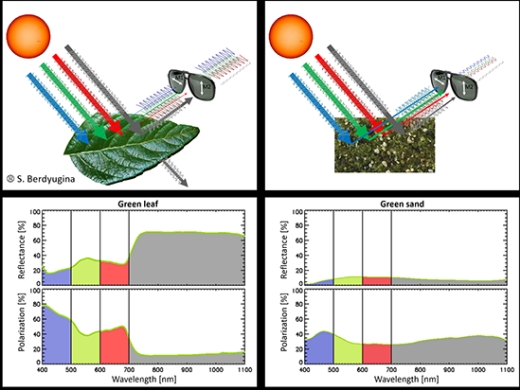
Image: A green leaf absorbs almost all red, green and blue light (RGB), but it reflects and transmits infrared light (shown in grey). The reflected infrared light is only weakly polarized due to the reflection of a healthy leaf, but the reflected RGB light is strongly polarized due to biopigments. Measuring the amount of polarized light at different colors reveals the signature of the leaf biopigments. Green sand reflects and polarizes sunlight almost equally in all wavelengths, which distinguishes it from a leaf that is a similar color. Similarly, yellow plants are different from yellow sand, etc. Credit: S. Berdyugina.
In their 2016 paper, the researchers discuss their development of a detection mechanism based on polarimetry, working with a laboratory experiment measuring the optical polarized spectra of samples both biological and non-biological. The paper investigates a range of biomolecules that capture stellar photons and store their energy in chemical bonds, examining plants with various pigments and likewise measuring non-biological materials like rock and sand.
The results, drawn on modeling of the polarized spectra of Earth-like planets in a variety of configurations — degree of surface coverage by photosynthetic organisms, empty land areas and ocean — show how useful polarized spectra can be at detecting photosynthetic pigments. Bear in mind when considering future observations that even with upcoming giant telescopes, we will not be able to image a planetary surface directly. Instead, we will use changes in the rotational signature of the planet as it moves about its star to learn about surface properties.
This rotational signature should prove extremely helpful, as the paper notes, although it requires large telescopes. Moreover, the contrast achievable in detected light depends on the kind of star we are dealing with and the wavelengths we are working at. From the paper:
It is feasible that the contrast down to 10-8 can be achieved with the current technology. However, to collect the necessary amount of photons in order to achieve such a high contrast for small planets requires extremely large telescopes. It appears that 25-40 m telescopes will be able to see only a few such planets. Large telescopes, such as the 75 m Colossus telescope are needed to investigate hundreds of Earth-like planets in stellar habitable zones (Kuhn & Berdyugina, 2015), but even such large telescopes will be able to detect their light with a sufficient SNR at very low spectral resolution or in broad bands. The fact that absorption and polarization features of biopigments are extremely broad allows for filters designed to provide enough detail on their possible photosynthetic origin.
Such filters give us, in other words, a tool that can distinguish a living from a non-living world. And not just in terms of vegetation. The paper goes on to note that the same biosignature is produced by bacteria and archaea, both of which use biopigments to harvest stellar light, as well as to protect themselves from dangerous UV radiation. Applying the techniques in this paper to the study of microorganism signatures through polarized light is an ongoing project.
This work may remind you of Nancy Kiang’s work on the spectral signatures of photosynthesis at NASA Goddard. Finding the right absorption band in the spectrum of an exoplanet can be tricky, as Kiang has shown by studying the colors of pigments and how they might change depending on the spectral class of the host star (see Beyond the Red Edge). On Earth, the colors of our land plants depend upon pigments that absorb in the visible blue and red, giving us green and yellow plants, but M-class dwarfs may have their peak absorption in the blue and near-infrared part of the spectrum, as Berdyugina and colleagues note. Thus we have to bear in mind how photosynthetic pigments might adapt depending on incident starlight. From Berdyugina et al:
It is worth also to note that a lack of blue photons in cool M stars will probably require a more complex mechanism for splitting water molecules into hydrogen and oxygen involving three or four photons instead of two as it occurs in terrestrial organisms. Therefore, understanding properties of radiation reflected from various photosynthetic organisms may help to identify such life forms on distant planets. This is the primary goal of our study.
Thus the paper identifies the signatures of biological pigments that can be used for biomarker detection, developing models of Earth-like planets with different coverage conditions of land and ocean, vegetation and clouds. The investigation of polarization winds up showing that linear polarization becomes the most potent method for detection of such biomarkers, citing “…very sensitive and rather unambiguous detection of photosynthetic pigments of various kinds.”
The paper is Berdyugina et al., “Remote sensing of life: polarimetric signatures of photosynthetic pigments as sensitive biomarkers,” International Journal of Astrobiology 15 (1): 45-56 (2016). Full text.

A ‘Census’ for Civilizations
We’ve been talking about the Colossus project, and the possibility that this huge (though remarkably lightweight) instrument could detect the waste heat of extraterrestrial civilizations. But what are the chances of this, if we work out the numbers based on the calculations the Colossus team is working with? After all, Frank Drake put together his famous equation as a way of making back-of-the-envelope estimates of SETI’s chances for success, working the numbers even though most of them at that time had to be no more than guesses.
Bear in mind as we talk about this that we’d like to arrive at a figure for the survival of a civilization, a useful calculation because we have no idea whether technology-driven cultures survive or destroy themselves. Civilizations may live forever, or they may die out relatively quickly, perhaps on a scale of thousands of years. Here Colossus can give us useful information.
The intention, as discussed in a paper by Jeff Kuhn and Svetlana Berdyugina that we looked at yesterday (citation below), is to look out about 60 light years, a sphere within which we have numerous bright stars that a large instrument like Colossus can investigate for such detections. We’re making the assumption, by looking for waste heat, that civilizations living around such stars could be detected whether or not they intend to communicate.
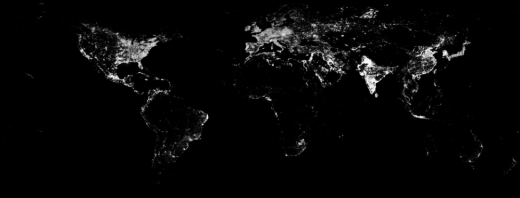
Image: Figure 1 from Kuhn & Berdyugina, “Global Warming as a Detectable Thermodynamic Marker of Earth-like Extrasolar Civilizations: The case for a Telescope like Colossus.” Caption: Man-made visible light on the Earth in 2011. From DMPS/NASA. The brightest pixels in this 0.5 × 0.5 degree resolution map have a radiance of about 0.05 × 10?6 W/cm2/sr/micron. Credit: Jeff Kuhn/Svetlana Berdyugina.
Let’s take the fraction of stars with planets as 0.5, and the fraction of those with planets in the habitable zone as 0.5, numbers that have the benefit of Kepler data as some justification, unlike Drake’s pre-exoplanet era calculations. Kuhn and Berdyugina have to make some Drake-like guesses as they run their own exercise, so let’s get really imaginative: Let’s put the fraction of those planets that develop civilizations at the same 0.5, and the fraction of those that are more advanced than our own likewise at 0.5. These numbers operate under the assumption that our own civilization is not inherently special but just one of many.
Work all this out and we can come up with a figure for the fraction of civilizations that might be out there. But how many of them have survived their technological infancy?
Let me cut straight to the paper on the outcome of the kind of survey contemplated for Colossus, which is designed to include “a quantifiably complete neighborhood cosmic survey for [Kardashev] Type I civilizations” within about 20 light years of the Sun, but one that extends out to 60 light years. In the section below, ? stands for the ratio of power production by an extraterrestrial civilization to the amount of stellar power it receives (more on this in a moment).
From the paper:
…current planet statistics suggest that out of 650 stars within 20 pc at least one quarter would have HZEs [Habitable Zone Earths]. Assuming that one quarter of those will develop ? ? 0.01 civilizations, we arrive at the number of detectable civilizations in the Solar neighbourhood ND = 40fs, where fs is the fraction of survived civilizations (i.e., civilizations that form and survive). Hence, even if only one in 20 advanced civilizations survive (including us at the time of survey), we should get a detection. Taking into account the thermodynamic nature of our biomarker, this detection is largely independent of the sociology of detectable ETCs.
Independent because we are not relying on any intent to communicate with us, and are looking for civilizations that may in fact be advanced not far beyond our own level, as well as their more advanced counterparts, should they exist.
Suppose we detect not a single extraterrestrial civilization. Within the parameters of the original assumptions, we could conclude that if a civilization does reach a certain level of technology, its probability of survival is low. That would be a null result of some consequence, because it would place the survival of our own civilization in context. We would, in other words, face old questions anew: What can we do to prevent catastrophe as a result of technology? We might also consider that our assumptions may have been too optimistic — perhaps the fraction of habitable zone planets developing civilizations is well below 0.5.
But back to that interesting figure ?. The discussion depends upon the idea that the marker of civilization using energy is infrared heat radiation. Take Earth’s current global power production to be some 15 terawatts. It turns out that this figure is some 0.04 percent of the total solar power Earth receives. In this Astronomy article from 2013, Kuhn and Berdyugina, along with Colossus backers David Halliday and Caisey Harlingten, point out that in Roman times, the figure for ? was about 1/1000th of what it is today. Again, ? stands for the ratio of power production by a civilization to the amount of solar power it receives.
The authors see global planetary warming as setting a limit on the power a civilization can consume, because both sunlight from the parent star as well as a civilization’s own power production determine the global temperature. To produce maximum energy, a civilization would surely want to absorb the power of all the sunlight available, increasing ? toward 1. Now we have a culture that is producing more and more waste heat radiation on its own world. And we could use an instrument like Colossus to locate civilizations that are on this course.
In fact, we can do better than that, because within the 60 light year parameters being discussed, we can study the heat from such civilizations as the home planet rotates in and out of view of the Earth. Kuhn and Berdyugina liken the method to studying changes of brightness on a star. In this case, we are looking at time-varying brightness signals that can identify sources of heat on the planet, perhaps clustered into the extraterrestrial analog of cities. A large enough infrared telescope could observe civilizations that use as little as 1 percent of the total solar power they intercept by combining visible and infrared observations. A low value of ? indeed.
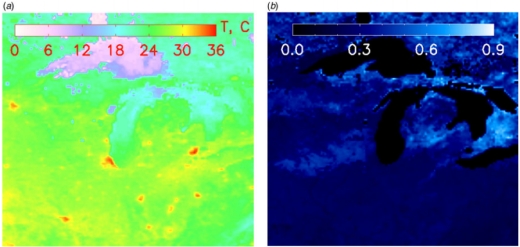
Image: Figure 3 from the Kuhn/Berdyugina paper “Global Warming as a Detectable Thermodynamic Marker of Earth-like Extrasolar Civilizations: The case for a Telescope like Colossus.” Caption: Fig. 3. Expanded view of a representative North American region illustrating temperature perturbation due to cities (left, heated cities are seen in red) and corresponding surface albedo (right). From NEO/NASA.
You can see what a challenge this kind of observation presents. It demands, if the telescope is on the ground, adaptive optics that can cancel out atmospheric distortion. It also demands coronagraph technology that can distinguish the glow of a working civilization from a star that could be many millions of times brighter. And because we are after the highest possible resolution, we need the largest possible collecting area. The contrast sensitivity at visible and infrared wavelengths of the instrument are likewise crucial factors.
I’ll refer you to “New strategies for an extremely large telescope dedicated to extremely high contrast: The Colossus Project” (citation below) for the ways in which the Colossus team hopes to address all these issues. But I want to back out to the larger view: As a civilization, we are now capable of building technologies that can identify extraterrestrial cultures at work, and indeed, instruments like Colossus could be working for us within a decade if we fund them.
We can add such capabilities to the detection of non-technological life as well, through the search for biomarkers that such large instruments can enable. More on that tomorrow, when I’ll wrap up this set on Colossus with a look at photosynthesis signatures on exoplanets. Because for all we know, life itself may be common to habitable zone planets, while technological civilization could be a rarity in the galaxy. Learning about our place in the universe is all about finding the answers to questions like these, answers now beginning to come into range.
The Colossus description paper is Kuhn et al., “Looking Beyond 30m-class Telescopes: The Colossus Project,” SPIE Astronomical Telescopes and Instrumentation (2014). Full text. The paper on Colossus and waste heat is Kuhn & Berdyugina, “Global warming as a detectable thermodynamic marker of Earth-like extrasolar civilizations: the case for a telescope like Colossus,” International Journal of Astrobiology 14 (3): 401-410 (2015). Full text.

Colossus and SETI: Searching for Heat Signatures
Yesterday we looked at the PLANETS telescope, now under construction on the Haleakala volcano on the island of Maui. What will become the world’s largest off-axis telescope is considered a pathfinder, part of the progression of instruments that will take us through the array of sixteen 5-meter mirrors that will be called ExoLife Finder, itself to be followed by Colossus, an instrument comprised of 58 independent off-axis telescopes. Colossus will use ultra-thin mirror technologies and interferometric methods to achieve an effective resolution of 74 meters. And it will be optimized for detecting extrasolar life and extraterrestrial civilizations.
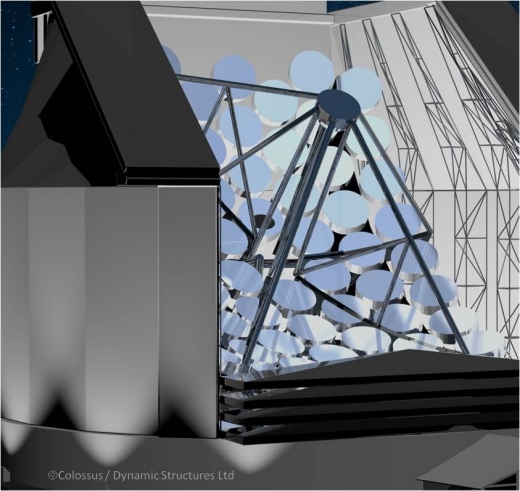
Image: Artist’s rendering of the Colossus telescope. Credit: Colossus/Dynamic Structures Ltd.
How to build something on such a scale? The design work is being handled by a consortium led by Jeff Kuhn (University of Hawaii), Svetlana V. Berdyugina (University of Hawaii/Kiepenheuer Institut für Sonnenphysik), David Halliday (Dynamic Structures) and businessman Caisey Harlingten, backed by an international team of astronomers associated with the PLANETS Foundation, as we saw yesterday. Building an instrument of this scale calls for innovation across the board, especially in terms of reducing weight and heightening resolution.
Thus Colossus relies upon extremely lightweight mirrors that deploy electromechanical force actuators that control the mirror’s shape and provide its stiffness. These mirrors are not separated from their electromechanical backing structure after manufacturing, depending on a network control system to fix their shape. In this overview of the Colossus design, they are described as ‘live mirrors,’ unlike normal telescope optics because they have much less mass and can be created without conventional grinding.
Civilization and Heat
An instrument like this has sufficient aperture and scattered light suppression to detect exoplanet biomarkers and, if they exist, the markers of extraterrestrial civilizations. It’s on this latter issue that I want to focus today. Over the past few years, we’ve delved into what is being called ‘Dysonian SETI,’ the search for other civilizations not through dedicated beacons but astronomical evidence of their activities. The reference to Freeman Dyson goes back to his description of spherical structures for gathering the total luminosity of a host star, the so-called Dyson sphere, or as it is also imagined, the Dyson ‘swarm’ of energy-gathering technology.
Richard Carrigan, a scientist emeritus in the Accelerator Division at the Fermi National Accelerator Laboratory, has run searches for such objects using data from the Infrared Astronomical Satellite (IRAS) mission (1983), which he believes sensitive enough to find Dyson spheres out to about 300 parsecs. But he is hardly the only one to mount such searches. The Russian radio astronomer Vyacheslav Ivanovich Slysh likewise surveyed infrared data for Dyson signatures, as did M. Y. Timofeev, collaborating with Nikolai Kardashev, in an attempt to scan the same IRAS data.
Carl Sagan, working with Russell Walker, was analyzing “The Infrared Detectability of Dyson Civilizations” (a paper in The Astrophysical Journal) back in the 1960s, noting the problems of distinguishing a Dyson sphere signature from natural phenomena. I won’t go deeper in this direction, though if you’re interested, the archives here cover the various search attempts as well as the ongoing work of the Glimpsing Heat from Alien Technologies group at Ohio State (see Archaeology on an Interstellar Scale and G-HAT: Searching for Kardashev Type III for more references on recent work). The point is that we have yet to find something that can be identified as a Dyson sphere or swarm despite repeated attempts.
The building of Colossus would allow us to move beyond the enormous Dyson constructs (spherical structures with planetary-like radii) to examine much weaker, but surely more likely, heat signatures from an active extraterrestrial civilization. Running a civilization takes power, and we know that by virtue of the laws of thermodynamics, power produces heat. Notice that in both Dysonian searches and these attempts to find heat as a byproduct of a civilization’s ongoing activities, we are not assuming any intent to communicate on the part of the extraterrestrial culture. We are simply trying to observe the unavoidable consequence of being a tool-using civilization that has reached a certain level of development.
In a paper looking at Colossus and its application to this search, Jeff Kuhn and Svetlana Berdyugina explain the point this way:
Waste heat is a nearly unavoidable indicator of biological activity, just as the energy that civilization consumes is eventually reintroduced into the planetary environment as heat. On planetary scales, biologically produced heat tends to be spatially clustered, just as an ET civilizations’ technological heat is difficult to distribute uniformly. Planetary surface topography and the efficient tendency for population to cluster in agrarian and urban domains leads to heat ‘islands’ (cf. Rizwan et al. 2008).The temporal and spatial distribution of this heat can be an observable ‘fingerprint’ for remote sensing of civilizations. Here we argue that we may soon be in a position to detect this thermodynamic signal from Type I, nearly Earth-like civilizations.
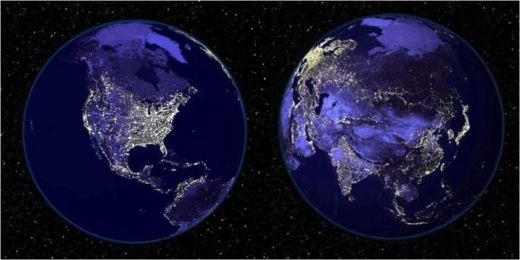
Image: The Earth at night seen from space (NASA). Colossus will be able to detect similar patterns of advanced civilization heat islands. Credit: Colossus consortium.
A search for Dyson spheres assumes a Kardashev Type II civilization, one capable of using the total energy output of its system’s star, according to the scale Nikolai Kardashev devised in 1964. But Kuhn and Berdyugina argue that an instrument like Colossus is capable of looking for Kardashev Type I, those civilizations capable of using all the energy available to their planet from its star. The argument here is that Type I civilizations (we are sometimes said to be at about Kardashev level .07) will inevitably evolve toward greater power consumption.
The correlation between power consumption and accumulated information content is a strong one in our society. In fact, we humans collect information with a doubling time on the order of two to three years, while our power consumption increases at a pace that outstrips population growth (global power consumption grows by about 2.5 percent per year, while the world’s population grows at something less than half this rate). The assumption, then, is that even a very efficient advanced civilization will still have high power requirements because of the cost to build and use its base of information. As cultures mature, information content grows.
But as we’ll see tomorrow, there are limits on the power a civilization can consume at the planetary level. And waste heat radiation can become a powerful signature for detection with the right equipment. A tool like Colossus, operating not with a wide field of view like most of the giant telescopes in the pipeline but observing only a few arcseconds of the sky at a time, would be capable of studying nearby planets in the habitable zone of their stars to detect such waste heat. A survey of stars within roughly 60 light years of the Sun could thus help us identify an extraterrestrial civilization or, just as important, demonstrate the lack of same.
More on Colossus tomorrow as we look at its methods, and address the question of whether technological civilizations survive. We can’t know the answer to this yet, but beginning a statistical survey of nearby stars is one way to get a glimpse of our own possible destiny. We also need to think about giant telescopes and their capabilities at detecting photosynthetic organisms in extrasolar systems. We may not find civilizations, but we can still find life.
The Colossus description paper is Kuhn et al., “Looking Beyond 30m-class Telescopes: The Colossus Project,” SPIE Astronomical Telescopes and Instrumentation (2014). Full text. The paper on Colossus and waste heat is Kuhn & Berdyugina, “Global warming as a detectable thermodynamic marker of Earth-like extrasolar civilizations: the case for a telescope like Colossus,” International Journal of Astrobiology 14 (3): 401-410 (2015). Full text. For the overview on Colossus, see the project’s home page.

PLANETS Telescope: Building Toward Colossus
Let me call your attention to the PLANETS telescope, now seeking a funding boost through an ongoing Kickstarter campaign. Currently about halfway built, the PLANETS (Polarized Light from Atmospheres of Nearby ExtraTerrestrial Systems) instrument is located on the 10,000 foot Haleakala volcano on the island of Maui. When completed, it will be the world’s largest off-axis telescope (at 1.85 meters) for night-time planetary and exoplanetary science. And it’s part of a much larger, scalable effort to find life around nearby stars in as little as a decade.
An off-axis design removes obstructions to the light path like the secondary mirror supports that can cause diffraction effects and lower image quality in axially symmetric reflective telescopes. Here light from the primary mirror is deflected slightly out of the incoming lightpath, limiting diffraction and scattered light. The PLANETS Foundation, the international collaboration of scientists and engineers behind the new telescope, sees it as a test of “low scattered light off-axis optics” as well as cutting edge “thin mirror technology.” The lightweight PLANETS mirror is 90 percent polished — using a tool called HyDRa (developed at the National Autonomous University of Mexico) that has demonstrated 1/100th of a wavelength polish — and key mechanical components of the off-axis design are waiting to be built.
The PLANETS instrument will be optimized for studying the exo-atmospheres of the rocky planets in our own Solar System, but will also delve into the atmospheres and surfaces of bright nearby exoplanets and examine circumstellar disks in young stellar systems. It also sets the stage for biosignature detection as we begin to upgrade its scalable technologies.
As a pathfinder, the PLANETS instrument is the beginning of a 10-year roadmap that aims to make telescopes that are lighter and less costly than the large instruments we currently use to probe the universe. The goals here are impressive: To create a census for life on several hundred of the nearest habitable zone exoplanets. The next step would be an instrument called ExoLife Finder, a circular array of sixteen 5-meter mirrors, using the ‘printed mirror’ technology and lessons learned from the PLANETS telescope to create a hybrid interferometer. With a total diameter of some 40 meters, ELF would be the first telescope to create surface maps of nearby exoplanets, including the one on our doorstep, Proxima b.
But beyond ELF we have Colossus, consisting of 58 independent off-axis telescopes that combine their data using interferometric methods to produce a 74-meter diameter effective resolution. Colossus and its capabilities will be the subject of tomorrow’s post, but for today I’ll note that the $600 million instrument could itself be built in a scant 96 months, according to the PLANETS Foundation site, once funding has been secured. An array based on scalable Colossus concepts could even become an optical system for beamed sailcraft of the kind envisaged by Breakthrough Starshot. But before we do all this, we have to build PLANETS.
The PLANETS telescope is backed by a number of academic sources including Japan’s Tohoku University, Germany’s Kiepenheuer Institute and the Institute for Astronomy in Hawaii, along with technology organizations like HNu Photonics and Dynamic Structures. Completion is expected in 2019, with a total cost of $4 million and approximately $500,000 left to raise. Thus the Kickstarter campaign is a cog in a larger effort. The initial Kickstarter goal of $20,000 goes toward finishing the polishing of the secondary mirror for the instrument, with a stretch goal of $45,000 that would be applied to building the primary telescope support system.
This instrument will demonstrate the ultra thin mirror concepts and hybrid interferometry needed to create an ELF within five years, and a Colossus within a decade. If you can help, please join this effort, and note the ExoCube, a 3D laser engraved glass map of potentially habitable worlds, that is available to supporters in a variety of styles featuring a range of mineral sphere ‘planetary’ add-ons. The Kickstarter site’s videos give you the overview.

Tomorrow we’ll delve deeper into Colossus and talk about the markers it could identify not only in terms of biosignatures but signs of possible technological civilizations.

